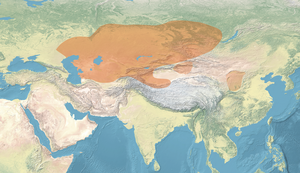| Geographical range | South Central Siberia |
|---|---|
| Period | Iron Age |
| Dates | ca. 9th–4th centuries BC |
| Preceded by | Begazy–Dandybai culture, Irmen culture |
| Followed by | Korgantas culture |
The Tasmola culture was an early Iron Age culture during the Saka period (9th to 4th centuries BC) in central Kazakhstan.[2][3][4] The Tasmola culture was replaced by the Korgantas culture.[3] They may correspond to the Issedones of ancient Greek sources.[5]
- ^ Ivanov, Sergei Sergeevich (2023). "Asia, Steppe, East: Early Iron Age Pastoralist Cultures". Reference Module in Social Sciences: Fig.1. doi:10.1016/B978-0-323-90799-6.00253-6. ISBN 9780443157851.
- ^ Cite error: The named reference
ABwas invoked but never defined (see the help page). - ^ a b Gnecchi-Ruscone, Guido Alberto; Khussainova (26 March 2021). "Ancient genomic time transect from the Central Asian Steppe unravels the history of the Scythians". Science Advances. 7 (13). Bibcode:2021SciA....7.4414G. doi:10.1126/sciadv.abe4414. ISSN 2375-2548. PMC 7997506. PMID 33771866.
The Tasmola culture in central and north Kazakhstan is among the earliest major IA nomad warrior cultures emerging (eighth to sixth century BCE)
- ^ Barrows with stone ranges of the Tasmola culture - UNESCO World Heritage Centre
- ^ Ivanov, Sergei Sergeevich (2023). "Asia, Steppe, East: Early Iron Age Pastoralist Cultures". Reference Module in Social Sciences. doi:10.1016/B978-0-323-90799-6.00253-6. ISBN 9780443157851.
Based on some information from literary sources it was suggested that the areas of the Tasmola Culture distribution can be correlated with the territory of the Issedones tribal group habitat. The Pazyryk Culture of the Altai Mountains, which also covered the mountains of Eastern Kazakhstan, could be associated with the semi-legendary people of the "gold guarding vultures"

